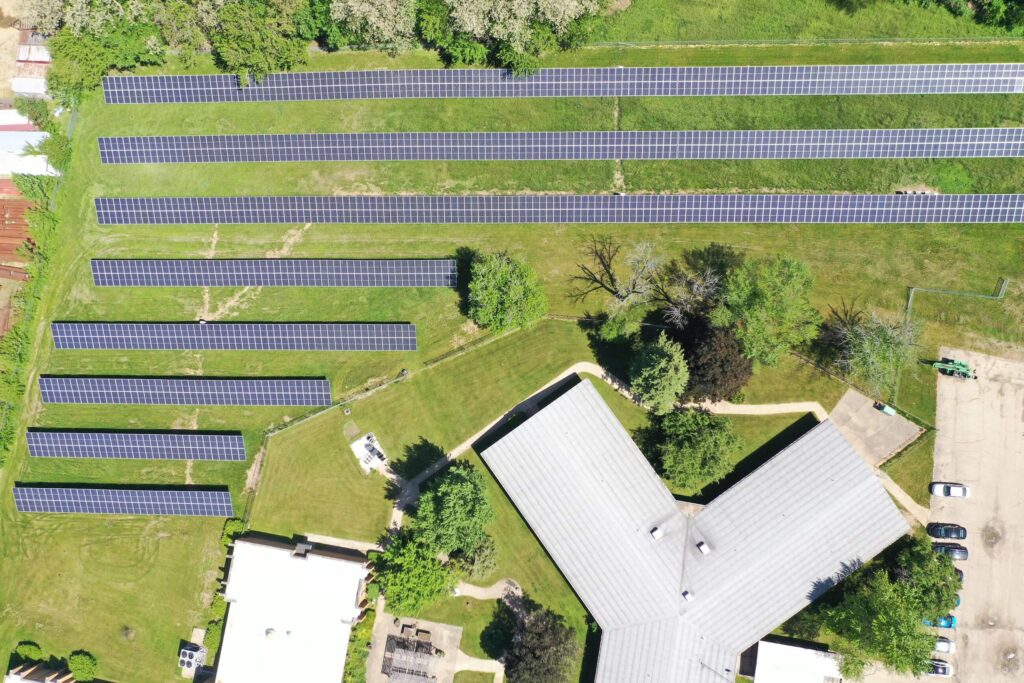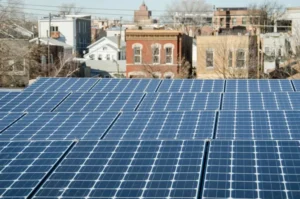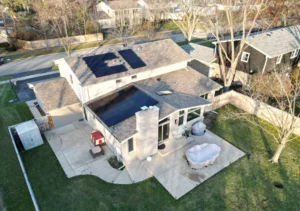The Fog of Uncertainty Has Lifted, Revealing a New Game Board.
The last year in the solar industry has been a masterclass in confusion. Whispers about the 30% federal tax credit ending turned into a roar, leaving homeowners adrift in a fog of uncertainty, wondering if the game was over before they could even make a move.
But then the fog lifted. And what it revealed is the single greatest solar opportunity in Illinois history.
The federal tax credit didn’t die. It was locked in at a full 30%. And it now sits at the top of Illinois’ legendary Triple Stack of incentives. For a brief window of time, you can get all three at once:
- 30% from the Federal Tax Credit (if you sign a contract and place a deposit with us before July 4th, 2026)
- Roughly 30% from the Illinois Shines (SREC) program.
- Up to 10% from a utility smart inverter rebate. (if your address is in ComEd or Ameren territory)
Let’s do that math like a Craftsman, not a Calculator. When you strategically combine these powerful financial tools, they can cover up to 70% of your total installation cost.
This isn’t a marketing gimmick; it’s a policy calendar. To get all three, you have to act before the programs change. The current window is set to close on July 4th, 2026. After that, this perfect alignment of incentives may be gone for good.
The result? With the right strategy, we’re seeing homeowners achieve a full return on their investment in as little as 1-3 years, depending on their energy usage.
Let’s clear the air: The game hasn’t ended. But the rules are new.
The U.S. Treasury has finally released its official guidance (Notice 48E), and it’s the long-awaited rulebook for every commercial project moving forward. It cuts through the noise and replaces speculation with strategy. We’ve done the homework so you don’t have to.*
The message is simple: Stop worrying. Start planning.
Let’s Start with the Only Question That Matters: Why Haven’t You Gone Solar Yet?
Let’s be honest. If the 30% federal tax credit is a key driver for your investment in renewables, the last few years have been the time to act.
So, why are you still reading this instead of generating your own power?
If you’re like most business owners we talk to, the answer isn’t a lack of interest. It’s been a lack of clarity. You’ve been trying to make a major financial decision in a fog of uncertainty.
“Will the tax credit disappear?”
“What if the rules change again?”
“How do I know who to trust?”
Those were all valid reasons for hitting the pause button.
But the fog has lifted.
The U.S. Treasury has released its final guidance. The rules are now set in stone. The excuses—the perfectly legitimate reasons for waiting—are gone.
And now that we can see the entire landscape clearly, the picture is even better than we thought. It turns out, the 30% federal credit isn’t the whole story. For Illinois homeowners, it’s just the first chapter.
The real story is the powerful alignment of incentives available right now. Think of it as a three-layer financial engine.
It starts with the 30% federal tax credit as your foundation. But here in Illinois, it gets much more interesting. The Illinois Shines program adds a second, massive layer, paying you for the clean energy you generate through SRECs, which can cover another 30% of your system’s cost. On top of that, your local utility—ComEd or Ameren—provides a direct cash rebate for installing a smart inverter, kicking in another 10%.
This isn’t fuzzy math. When you combine the federal credit, the state-level SREC payments, and the direct utility rebate, you are looking at a scenario where up to 70% of your entire system cost can be covered by incentives you are entitled to claim.
This isn’t a sale. It’s not a limited-time offer from a dealer.
This is the established, locked-in financial reality of going solar in Illinois right now.
The old question was, “What if?”
The new question is, “How do I make sure I get my 70%?”
Your Two Paths to Lock In the 30% Tax Credit
The government has given you two simple ways to secure your tax credit. You just have to pick one and act before July 5, 2026.
Path A: The “Game Plan on Paper” Play
This is the capital plan. It’s even simpler. You can secure your full 30% tax credit with a strategic project deposit to Windfree Solar..
You don’t have to spend big money. You just have to show you’re committed. Our usual deposit of 10% at contract signing with us isn’t just a down payment; it allows you to safely harbor your tax credit for up to 4 years from when the payment is made OR have racking installed by July 4th, 2026 and have your credits until July 4th, 2030.
Path B: The “Boots on the Ground” Play
This is the action plan. To lock in your credit, we just need to start physical work. This doesn’t mean the whole project has to be built. It can be as simple as installing the first few pieces of solar racking on your roof.
It’s a tangible first step that says, “This project is happening.”
Deconstructing the Deadlines: Your Key Dates and Definitions
Knowing your play is half the battle. The other half is knowing the clock.
The new Treasury guidance isn’t just a set of tasks; it’s a timeline. And understanding the nuances of that timeline—what happens after you start, and when you truly need to finish—is just as critical as knowing how to begin.
Let’s put the deadlines under the microscope.
The Hard Deadline: July 5, 2026
This is the date that governs everything. It is the immovable point around which your entire strategy must revolve.
There is no ambiguity here. This date is your line in the sand.
The “Continuity” Requirement: What Happens After You Start?
This is the detail that trips up the unprepared. Starting construction or spending 5% is not a one-and-done event. The Treasury has built in a “continuity requirement” to ensure projects maintain momentum.
You can’t just drive a stake in the ground, lock in a 30% tax credit, and then walk away for two years. You have to keep the ball moving down the field.
- For the Physical Work Path: This is called the “Continuous Construction” requirement. While you don’t have to have crews on-site every single day, you must demonstrate ongoing and meaningful progress toward completion.
- For the 5% Safe Harbor Path: This is called the “Continuous Effort” requirement. If you’ve qualified by spending 5% of the project cost, you must continue to make progress through activities like engineering, securing permits, or ordering equipment. Your 10% deposit at contract signing with Windfree Solar covers your 5% spend requirement.
This rule is designed to weed out speculative projects from real ones. For our clients, it’s simply a formal name for what we already do: drive projects forward relentlessly until they are complete
The Finish Line: The “Placed-in-Service” Window
After all this talk of urgent deadlines, here’s a breath of fresh air.
Once you have successfully locked in your 30% credit by meeting the July 5, 2026 deadline, the pressure shifts. The Treasury provides a generous window to finish the job. If you sign a contract with Windfree Solar and pay the deposit you have 4 years to construct the project from the date that you paid the initial deposit on the contract.
You have a full four years from your qualification date to complete construction and place the project in service.
“Placed in service” means the system is fully installed, has passed all testing, has received permission to operate from the utility, and is officially generating power. This four-year window is crucial. It’s the built-in breathing room that accounts for the realities of large-scale construction, from supply chain delays to weather disruptions. It ensures that a well-planned project has the time it needs to be a well-built project.
Your Quarterback Matters More Than Ever
A playbook is a powerful tool. It provides clarity and a path to victory. But a playbook doesn’t win the game. Players do.
In a complex game with a fixed clock and millions of dollars on the line, you need an expert quarterback calling the plays. You need a partner who doesn’t just know the rules but has a proven record of executing under pressure, navigating the chaos, and driving the ball down the field.
This is where credentials stop being logos on a website and start being proof of capability. After reading this playbook, the why behind our qualifications should be crystal clear:
- Because you need to navigate the gauntlet of ComEd or Ameren ’s interconnection queue, you need a partner with a deep portfolio of successful Ameren & ComEd projects who knows the people and the process inside and out.
- Because you need to trust your contractor with a significant capital investment, you need a partner who can bond a $12 million project, proving the financial stability and scale required to eliminate risk.
- Because the federal tax credit is only one piece of the financial puzzle, you need an ICC Certified Licensed Installer, an approved vendor of the Illinois Shines SREC program, and an Equity Eligible Contractor (EEC) who knows how to maximize every available state and federal incentive (Windfree Solar meets all of these requirements).
We don’t just build solar projects. We build certainty.
Your Next Move: From Playbook to Game Plan
The playbook is here. The path is clear. Now, it’s time to customize it for your specific project.
The clock is ticking, but with the right strategy, there is still ample time to win. The first step isn’t a contract; it’s a conversation. Let’s take this playbook and build your custom game plan.
Schedule a free project analysis with our commercial team to map out your 2026 playbook.
Information regarding the Federal Investment Tax Credit (FITC) is for general informational purposes only and does not constitute professional tax advice. It should not be used as the sole basis for making financial or tax decisions. Individuals and businesses should consult a qualified tax professional to determine their specific eligibility for the FITC, calculate the correct amount, and address any unique circumstances.




